Iranian rial dropped to 136,500 against U.S. dollar in the first week of the Iranian New Year (starting March 21). The exchange rate was 154,000 rials to a euro and 178,500 rials to a British pound. Tehran’s gold market also experienced a price increase. An Iranian Bahar Azadi coin (weigh 8.13 grams, pure gold content 7.317 grams) fetched $1,118.
Foreign exchange and gold markets have experienced a surge for the second consecutive year. Meanwhile, the Governor of the Central Bank Abdolnaser Hemmati has reiterated government’s commitment to stabilizing foreign exchange rates and gold prices. The dollar increased 174 percent in value against the rial in 2018-19.
The International Monetary Fund (IMF) said, in March of last year, that Iran had over $100 billion of gross official reserves. The reserve should have enabled Tehran to protect the rial. However, Iran could not access most of its reserves because the U.S. sanctions discouraged foreign banks from engaging in business with Tehran. Iranian rial will continue to perform poorly against the dollar and other foreign currencies, given Tehran’s failure to circumvent the sanctions.
The U.S. Department of the Treasury’s Office of Foreign Assets Control (OFAC) has warned the global maritime petroleum shipping community against “facilitating the shipment of petroleum destined for Syrian Government-owned and-operated ports, to include petroleum of Iranian origin.”
A statement by the OFAC said: “Shipping companies, insurers, vessel owners, managers, and operators must aggressively counter the ongoing deceptive shipping practices deployed by Iran and Syria and or questionable jurisdictions.”
[Translated from Persian by Fardine Hamidi]


